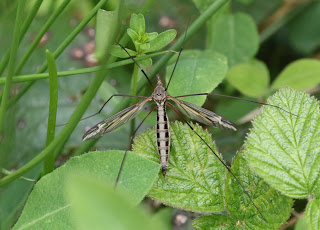Wednesday 27th April 2022, Hope Valley Shropshire Wildlife Trust Reserve
The Hope Valley reserve lies just to the north of the village of Hope in the steeply sided valley (at least on the woodland side) through which a stream, which may be called Minsterley Brook, flows.Getting there was a problem.
There were roadworks that had closed the road between Minsterley and Hope, the way we normally go to get to this reserve. However it was not as simple as that, at least for the car in which I was travelling.
At the roundabout where we turned onto the A488 from the A5 by Shrewsbury we noticed, too late, a diversion sign. We ploughed on in the hope that everything would be fine.
No sign of any roadworks but …
Passing through Pontesbury we noticed the sign of doom – “ROAD AHEAD CLOSED”.
Unfortunately it was not clear to us where the road was closed. At this point we took the decision to take an alternative route to Minsterley.
That turned out to be a total waste of time!
We got to Minsterley and turned back onto the A488 towards our goal believing that we had avoided the roadworks …
All went well until we got to Ploxgreen where we met the road closure.
Fortunately we were able to divert onto a minor road a little west of the A488 and get to Hope. There we could turn back towards our goal.
As we turned back onto the A488 at Hope we saw another “Road closed sign”.
We ignored this and managed to get to the site about 20 minutes late.
Expecting that others would also be held up, we were surprised to find everyone else on site and hard at work!
How at they got there so easily?
“We followed the Diversion.”
After the glorious weather of the previous days we were very disappointed to be greeted by cloudy, cool, breezy conditions.
The area by the car park is a damp grassland and this was scoured for lifeforms.
An early find was a Hawthorn shieldbug that was inhabiting a holly bush.
 |
| Photograph: David Williams |
The weather conditions were rather inhibiting anything from flying but one hoverfly did venture out, Epistrophe eligans.
 |
| Photograph: John Martin |
Our late arrival threw out any timetable that I may have had for the day so, as it was approaching lunchtime …
Yes, so soon! …
I decided to get the ascent to the top of the hill over and done with as quickly as possible.
By the time I got to the view point overlooking the Stiperstones at the top I was very alone.
Undeterred I tucked into my lunch and waited.
Others started to arrive, find perches and have their picnics.
It was not very long before everyone had made it to the top.
Various weevils were collected during the day. Here are two. I do not know when or where they were found, but now is as good a time as any to include photographs of a couple.
Curculio glandium;
 |
| Photograph: Emm Cane-Honeysett |
And the very similar Curculio venosus.
.JPG) |
| Photograph: Emm Cane-Honeysett |
Here is a striking “head-on” photograph of the same weevil.
.JPG) |
| Photograph: Emm Cane-Honeysett |
Lunch over we spent quite a long time exploring the area around the view point.
One discovery was this rugged looking beetle aptly named Carabus granulatus.
.jpg) |
| Photograph: David Williams |
Other finds were a spider that had been fungified. (I do not know if “fungified” is an accepted term - spellchecker does not think so - but it does describe the spider’s state.)
 |
| Photograph: David Williams |
And the bizarre looking Hazel leaf-roller weevil.
 |
| Photograph: David Williams |
In this high exposed area of the site the cold wind was biting through our clothing. It was time to move on and seek warmth and shelter amongst the trees.
We made our way slowly along the path that runs along the top of the hill.
An Eyed ladybird, with pale rings around its black spots, was uncovered.
 |
| Photograph: David Williams |
The large cranefly Tipula vittata was spotted on the vegetation.
 |
| Photograph: John Martin |
The sun came out and the temperature rose markedly just as we came to an area of the wood with more of its flora on display.
 |
| Photograph: David Williams |
We paused to enjoy the sight and check out if the sudden warmth had stirred the fauna into activity.
One group of insects often found swarming around the branches of a tree in the sun at this time of year is the “long-horned” moths. Really they should be called “long-antenned” moths but, I suppose, “long-horned” sounds more dramatic.
This one is Adela reaumurella.
 |
| Photograph: John Martin |
Time to get going and make our way back to the cars. On the way we spotted a leaf mine and a host of galls.
The leaf mine, on Honeysuckle, is caused by the fly larva of either Aulagromyza cornigera or Aulagromyza hendeliana. In order to determine which you need to examine the larva. In this leaf the larva had already vacated the mine.
 |
| Photograph: John Martin |
The galls on rowan were caused by a mite, Eriophyes pyri.
 |
| Photograph: John Martin |
And home we went by whatever circuitous route we could find to avoid the roadworks.
All that remains is to introduce you to the Wednesday Weevil of the Week which is the scarce Lasiorhynchites cavifrons, a very hairy, subtly blue-hued, large weevil.
.jpg) |
| Photograph: Emm Cane-Honeysett |
My thanks to the Shropshire Wildlife Trust for giving us permission to do what we enjoy doing and to the photographers for allowing me to use their images.





























No comments:
Post a Comment
Please feel free to comment on this post...